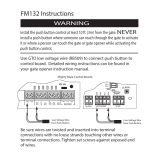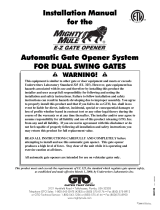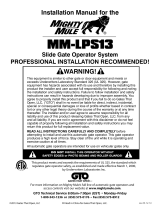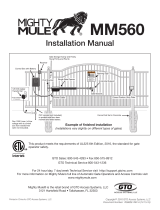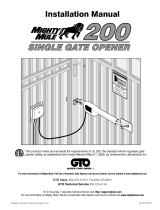Page is loading ...

1
PLEASE NOTE: Because of the various mounting applications, no mounting hardware is
provided with the GTO Automatic Gate Lock. All necessary mounting hardware can be ob-
tained from your local hardware store; all other hardware is provided.
This manual shows two examples of the most common installations, and should provide insight
into most other applications. If you have any questions during installation, please call (850)
575-0176 for technical support.
Installation Manual
RB909 rev-05/18/01
© GTO, Inc. 2000
AUTOMATIC
GATE LOCK
®
IMPORTANT: Before you install the automatic gate lock be sure your gate is level, moves freely on its
hinges, and does not bind or drag against the ground.

1
Be sure you have all the parts:
A - Lock with 20' of low voltage wire
B - Lock Receiver
C - Clevis Pin
D - Locking Cap
E - Lock Board Battery Lead Wires
F - White Wire
(motor lead to lock board)
G - Lock Control Board
H - 2 Double Spade Tongue terminals
I - 6 nylon cable ties
J - 3M
®
Scotch Loc
K - Lock Keys (for manual release)
L - Lock Decal
What else do you need?
Mounting hardware is not included. Read these instructions completely and review the installation examples to
determine the mounting hardware required for your application.
NOTE: The GTO Lock is designed to use mounting hardware up to
5
/16" in diameter. For a more secure installation,
use lock washers and lock nuts on all mounting hardware.
For most IRON or ALUMINUM TUBE gates you will need:
Bolts, washers, and nuts for the lock and receiver. (see Illustration B, page 3)
For most CHAIN LINK gates you will need:
U-Bolts, saddles or bolts, washers and nuts for the lock.
Bolts, washers, and nuts for the receiver. (see Illustration C, page 3)
The installation has two parts:
(1) Mounting The Lock
(2) Connecting the Control Boards
Once you have the necessary mounting hardware, you can begin the installation.
Before You Start...
For the GTO Automatic Gate Lock work properly, the gate must close firmly and engage the lock catch against
the lock receiver. Achieving optimal closure may require slight adjustments to the gate opener settings.
Installing the lock with the Mighty Mule E-Z Gate Opener
®
may require slight movement of the stroke
adjustment knob
(and changes to the obstruction sensitivity–on Generation 2000 Control Boards ONLY). See Setting
the Gate Closed Position in your Mighty Mule Installation Manual for information on these adjustments.
Installing the lock with a GTO/PRO gate opener may require slight movement of the stroke adjustment knob
and changes to the obstruction sensitivity (see your GTO/PRO Installation Manual for information on these
adjustments).
If you are installing the lock on a Push-to-Open gate (gate opens out), the lock must be installed on the
outside of the gate. Depending upon the installation, the gate post may need to be "pocketed" to accommodate
the lock receiver. Contact the GTO Service Department at (850) 575-0176 for assistance.
AUTOMATIC
GATE LOCK
®
B
A
C
D
E
F
G
H
I
J
K
L

2
Illustration A
Mounting The Lock:
Disconnect gate opener by removing hairpin clip and clevis pin from the gate bracket end of the
opener. Disconnecting the opener will allow the gate to swing freely during installation of the gate
lock. If you have a dual gate system, be sure to disconnect both gate openers.
Step 1: With the gate in the closed position, determine the best location for the lock and lock receiver. The lock
and receiver must be level and aligned with the opener. Also, the lock should have a solid surface or
cross member to provide stability.
Step 2:Clamp receiver and lock together (with receiver pin hole and lock slot aligned) against the gate post and
mark their positions to drill receiver holes (see Illustration B and C, page 3). The receiver must be
mounted with through bolts, not U-bolts, to allow lock to seat properly. Fasten the receiver to the gate
post.
Step 3: Recheck the lock position and alignment, then mark its position for drill holes. Drill the holes on gate
supports through the slots in the lock bracket. U-bolts and saddles can be used to mount the lock on
chain link gate supports. Secure the lock to the gate. Install clevis pin and locking cap by placing clevis
pin through slots in lock receiver and hammering the clevis pin into the locking cap (see Illustration D),
and check the alignment again.
Manual Lock Release:
The GTO Automatic Gate Lock is keyed for manual release. Should the electronic release be disabled for any
reason, simply use the key to manually open the lock.
Receiver pin hole and lock slot must line up.
Check alignment with pin out of receiver.
Lock and receiver must be level
and aligned with opener.

3
Clevis Pin
Receiver
Locking Cap
Lock
U-bolts, saddles & nuts
(not provided)
Added cross member
to support lock from
force of slammimg shut
Remember to check the alignment and mark positions before
drilling holes in fence post .
Illustration B
Iron or Aluminum Tube Fence and Gate Installation
Illustration C
Chain Link Fence and Gate Installation
Illustration D
Locking Cap
Assembly
Clevis Pin
Receiver
Locking Cap
GTO Automatic
Gate Lock
Carriage bolts, washers, and nuts
(not provided; size of
fasteners depends on the gate)
Remember to check the alignment and mark positions
before drilling holes in fence post and gate.

4
Connecting the Control Boards:
RED Wire To Battery
Positive (+) Terminal
RED Wire From Lock
BLACK Wire From Lock
WHITE Wire to
Motor Lead
BLACK Wire To Battery
Negative (–) Terminal
1
2
345
Lock Board
Lock Board
Wiring Chart
* Place a dab of petroleum
jelly on the terminal con-
tacts to prevent corrosion.
Step 1. Turn control box power switch OFF and unplug the transformer. Remove control box cover
and disconnect battery lead wires from the battery terminals before wiring the lock board.
Step 2.Connect the WHITE wire (included) to Terminal #1 on the lock board. Connect the RED
battery lead wire (included) to Terminal #5 on the lock board. Connect the BLACK Battery lead
wire (included) to Terminal #2 on the lock board. (See Wiring Chart). DO NOT connect
lock
board battery lead wires to battery until Step 6!
Step 3. Attach the RED control board battery lead wire to one spade tongue on a double spade tongue
connector (included). Attach the BLACK control board battery lead wire to one spade tongue
on the other double spade tongue connector (included).
Refer to the appropriate diagram for your opener (on pages 5–7) and the Wiring
Chart on this page as you follow these steps.
PLEASE NOTE:
If a diagram of your control board
and control box is not pictured on
page 5 please call the GTO
ServiceDepartment at (800) 543-
4283 or (850) 575-0176 for assis-
tance.
NOTE: The 3M
®
Scotch Loc Connector is not needed with Generation 2000 Control Boards. If
you have a Generation 2000 Control Board, skip step 4 and refer to the illustration on page 6.
Step 4. Attach the 3M
®
Scotch Loc Connector. Place the WHITE wire from the lock board inside the
“blocked” channel on the 3M
®
Scotch Loc Connector. If the gate opens into the property (pull-
to-open), place the BLACK wire from the opener power cable inside the “through” channel on
the 3M
®
Scotch Loc Connector. Crimp the 3M
®
Scotch Loc closed with pliers and fold plastic
locking tab into place until it locks shut.
NOTE: If the gate opens away from the property (push-to-open) place the RED wire from the opener
power cable inside the “through” channel on the 3M
®
Scotch Loc Connector. Crimp 3M
®
Scotch Loc closed with pliers and fold plastic locking tab into place until it locks shut.
If this is a dual gate installation, use the RED (push-to-open) or BLACK (pull-to-open) wire
that extends from the power cable to the opener. The opener must be mounted on the same gate
leaf that the lock is mounted to. This gate leaf must also be set to open first; see your Installa-
tion Manual for information about gate sequencing.
Step 5. Pull RED and BLACK wires from gate lock through the strain relief and into the control box.
Attach BLACK wire to Terminal #3 on lock board. Attach RED wire to Terminal #4 on lock
board (see Wiring Chart).
Step 6. Attach RED lock board battery lead wire to the double spade tongue terminal with the RED
control board lead wire. Attach the BLACK lock board battery lead wire to the double spade
tongue connector with the BLACK control board Lead Wire.
Step 7. Reconnect opener to gate bracket. Connect RED wires (with double spade tongue terminal) to
POSITIVE (+) battery terminal and the BLACK wires (with double spade tongue terminal) to
the NEGATIVE (–) battery terminal. Plug the transformer in and turn the control box power
switch ON. Test opener and lock to make sure it functions properly and make adjustments if
necessary.

5
SERIES
Lock Board
12 Volt Battery
Strain Relief
Double Spade
Tongue Terminals
Opener
Control
Board
R
E
D
&
B
L
A
C
K
P
A
I
R
F
R
O
M
L
O
C
K
B
L
A
C
K
B
L
A
C
K
(PRO)
3M® Scotch Loc Connector
Red Operator Lead and White Lock lead for push-to-open
Black Operator Lead and White Lock lead for pull-to-open (shown)
B
L
A
C
K
R
E
D
W
H
I
T
E
R
E
D
B
L
A
C
K
AUTOMATIC GATE OPENER
®
Lock Board
12 Volt Battery
Strain Relief
Double Spade
Tongue Terminals
3M® Scotch Loc
Black Operator Lead and White Lock Lead for Pull-To-Open
Opener
Control
Board
R
E
D
&
B
L
A
C
K
P
A
I
R
F
R
O
M
L
O
C
K
(Retail)
B
L
A
C
K
R
E
D
R
E
D
B
L
A
C
K
B
L
A
C
K
B
L
A
C
K
W
H
I
T
E
R
E
D
B
L
K
O
R
G
B
LU
G
R
N
C
LS
E
D
G
O
P
N
E
D
G
R
E
D
G
R
N
O
R
G
B
LU
W
H
T
B
LK
O
R
G
B
L
U
G
R
N
C
L
S
E
D
G
O
P
N
E
D
G
LEARN
A
U
T
O
C
L
O
S
E
IN
E
R
T
IA
S
T
A
T
U
S
P
U
L
L
/P
U
S
H
S
G
N
L
/D
U
A
L
S
E
Q
1
S
E
Q
2
MIN
MAX
MIN
MAX
OFF
60
120
B
ATT
+
–
O
B
S
T
R
.
S
E
N
S
.
RC
VR
R
G
B
A
LARM
SEC
O
N
D
O
PERA
TO
R
FIR
ST O
PERA
TO
R
PO
W
ER IN
1
8
V
A
C
S
O
L
A
R
~
~
–
+
AC
C
ESS
O
RY
PW
R. SW
.
Lock Board
12 Volt Battery
Strain Relief
Double Spade
Tongue Connectors
Opener
Control
Board
R
E
D
&
B
L
A
C
K
P
A
I
R
F
R
O
M
L
O
C
K
(Generation 2000)
B
L
A
C
K
R
E
D
R
E
D
W
H
I
T
E
B
L
A
C
K
For Generation 2000 Control
Boards (Mighty Mule, GTO/PRO
1000, GTO/PRO 2000 openers
WITH Serial Numbers)

6
1234
ON
SECOND OPERATORFIRST OPERATORPOWER IN ALARM ACCESSORY RCVR
PULL/PUSH
SNGL/DUAL
SEQ1
SEQ2
LEARN
18VAC SOLAR
~~– +
RED
BLK
ORG
BLU
GRN
CLS EDG
OPN EDG
RED
BLK
BLU
ORG
ORG
BLU
WHT
GRN
GRN
CLS EDG
OPN EDG
R G B
Power Cable
from First Operator
RED Wire To Battery
Positive (+) Terminal
RED Wire From Lock
BLACK Wire From Lock
WHITE Wire to
BLK OPERATOR Terminal
BLACK Wire To Battery
Negative (–) Terminal
1
2
345
Lock Board
Time Adj
MIN
MAX
The 3M
®
Scotch Loc Connector is not needed with the Generation 2000 control board (i.e., Mighty Mule
®
,
GTO/PRO 1000, and GTO/PRO 2000 openers with serial numbers. Connect the WHITE wire from the lock board
directly to the OPENER terminal block along with the power cable wire. Connect the WHITE wire to the BLACK
terminal for a Pull-to-Open installation (see illustration below), connect WHITE wire to the RED terminal for a
Push-to-Open installation. Proceed to Step 5 and connect the remaining wires as described.
Generation 2000 Control Boards (Mighty Mule
®
, GTO/PRO
1000, and GTO/PRO 2000 openers
with serial numbers)

7
If you have any questions please call the GTO Service Department:
(850) 575-0176
Limited One Year Warranty:
GTO, Inc. • 3121 Hartsfield Road • Tallahassee, Florida 32303 • (850) 575-0176 • Fax (850) 575-8912 • www.gtoinc.com
GTO, Inc., gate opener accessories are warranted by the manufacturer against defects in workmanship for a period of one
(1) year from the date of purchase, provided recommended installation procedures have been followed.
In the case of product failure due to defective material or manufacturer workmanship within the one (1) year warranty
period, the accessory will be repaired or replaced (at the manufacturer's option) at no charge to the customer, if returned
freight prepaid to GTO, Inc. 3121 Hartsfield Rd., Tallahassee, FL 32303.
IMPORTANT: Call (850) 575-0176 or Fax (850) 575-8950 for a Return Goods Authorization (RGA) number before
returning accessory to factory. Products received at the factory without an RGA will not be accepted. Replacement or
repaired parts are covered by this warranty for the remainder of the one (1) year warranty period or six (6) months,
whichever is greater. GTO, Inc. will pay the shipping costs (equivalent to United Parcel Service ground rate) for items
repaired under warranty.
The manufacturer will not be responsible for any charges or damages incurred in the removal of the defective parts for
repair, or for the reinstallation of those parts after repair. This warranty shall be considered void if damage to the product(s)
was due to improper installation or use, connection to an improper power source, or if damage was caused by lightning,
wind, fire, flood, insects, or other natural agent.
After the one (1) year warranty period, GTO, Inc. or one of its authorized service centers will make any necessary repairs
for a nominal fee. Call GTO at (850) 575-0176 for more information. This warranty gives you specific legal rights, and
you may also have other rights which may vary from state to state. This warranty is in lieu of all other warranties,
expressed or implied. NOTE: Verification of the warranty period requires copies of receipts or other proof of purchase.
Please retain those records.
Lock Board
12 Volt Battery
Strain Relief
Double Spade
Connectors
Operator
Control
Board
R
E
D
&
B
L
A
C
K
P
A
I
R
F
R
O
M
L
O
C
K
(PRO 2000)
B
L
A
C
K
R
E
D
R
E
D
B
L
A
C
K
W
H
I
T
E
15 15
RED
BLK
GRN
ORG
BLU
RED
BLK
GRN
WHT
BLU
ORG
GRN
RED
BLK
GRN
ORG
BLU
RED
BLK
RED
BLK
FIRST OPERATOR SECOND OPERATOR POWER IN ACCESSORY GTO RECEIVER
15 amp 15 amp
PRO 2000 Board
Terminal Blocks
TRANSFORMER
SOLAR
RED
RED
BLACK
BLACK
GREEN
GREEN
ORANGE
ORANGE
BL
BL
UE
UE
RED
BLACK
GREEN
ORANGE
BLUE
Power Cable
from First Operator
RED Wire To Battery
Positive (+) Terminal
RED Wire From Lock
BLACK Wire From Lock
WHITE Wire to
BLACK on Operator Terminal
BLACK Wire To Battery
Negative (–) Terminal
1
2
345
Lock Board
The 3M
®
Scotch Loc Connector is not needed with the GTO/PRO 2000
control board. Connect the WHITE wire from the lock board directly to
the OPENER terminal block along with the power cable wire. Connect
the WHITE wire to the BLACK terminal for Pull-to-Open installation
(see illustration), connect WHITE wire to the RED terminal for Push-to-
Open installation. Proceed to Step 5 and connect the remaining wires as
described.
/
